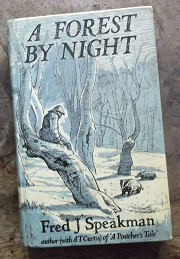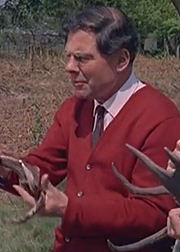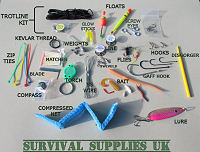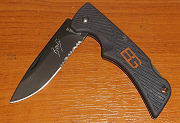|
A BIT ABOUT MY PERSONAL HISTORY

One of my collection
of Fred's books. |
As a nipper in London in the first half of the 60's I was lucky
enough to go to a junior school that sent us on field trips to
Epping Forest in Essex. Even luckier still, we made regular monthly
visits to the Epping Forest Field Studies Centre at Roseville, High Beach, run by none
other than Fred Speakman, one of Britain's best known bushcraft and
naturalist authors at that time. Fred taught us natural history and
bushcraft with a passion and those days at Roseville Field Centre
are some of my happiest memories from that time.
Once a month about a dozen of us
would be put on a small coach and arrive a little before ten in the
morning, sandwiches and thermos
flasks in our satchels. Fred would give
us a talk for an hour in a kind of "prefab" classroom and then take
us out for a long walk through the forest, pointing out all kinds of
things as we went and chatting with the forest rangers. We had small exercise books which we were
encouraged to take notes in as we went - although I seemed to be the
only kid doing any writing. When we arrived back at the centre a
couple of hours later we would eat our packed lunches and then draw and write about the things we'd
seen.
I consider myself very fortunate that Fred took me under his
wing and spent a lot of his time talking to me about the habits of
foxes, badgers, squirrels, how trees differed, wood lore and how to
set up a camp. I have no doubt at all that it was Fred who sparked
my life-long interest in wildlife and bushcraft.
|

Fred J Speakman out in
Epping Foerest, just as
I remember him. |
About the same time (or perhaps starting even earlier) my parents
would take my brother and I to Hainault Forest at weekends. From the
car park there was what seemed at the time to be a vast ocean of
green grass to traverse before you reached the actual forest and I
couldn't wait to get across it and get into the woods, where I spent
many a Sunday exploring.
As a kid growing up I was always a bit of an "adventurer";
while days were spent playing on and studying the wildlife living on
the local bomb sites, I loved to spend
nights out in the woods and, before long, I'd put together a kit of
what I needed ... my essential equipment. You know the kind of
things: spare string and tent pegs, things to help make the camp
fire, an old saucepan, pen-knife, etc. The more time I spent out
there the more situations I came across which I hadn't the tools or
equipment to deal with, so gradually things got added to my old army
surplus haversack.
Later on, a good mate and I used to take long distance hikes around the
country. We would hike no matter what the terrain and no matter what
the weather - even in blizzards and for up to two weeks at a time.
We bought the lightest tents to carry, the smallest stoves and even
drilled holes in our cutlery handles to reduce their weight. Yep, we
were bordering on the fanatical.
My enthusiasm has never waned (even if my physical fitness has) over
the years. I've put together many personal kits for camping and
surviving, especially spurred on by the technical progress that
outward bound equipment has made over the years.
THE IDEA BEHIND SSUK
Recently, however, I have been taking a look at the various
commercial
"survival kits" available and, while I won't criticise any of them
in particular, I have found quite a few of them lacking in many
aspects. Just as an example: the sewing kits included in many packs
are the sort of cheap thing you'd find in any hotel room in the
country and when I look on YouTube at people putting together their
own kits I see them using the same sort of crap. Now, I ask
you: who in their right mind (if they really thought about
it) would rely on a little kit consisting of ten different
colours of weak cotton as opposed to a couple of metres of very
strong black thread? I know from my own experience that the
inferior stuff is never going to hold a seam together for long, let
alone your torn shelter material ... and that's NOT a risk you can
take in the field.
That's just one example. So I looked at my own kit. I costed it out
and thought "Ah, that's why. It's difficult to put together a decent
kit at a price that people are willing or able to pay."
Now, that would have been it, if it hadn't been for feeling that
people were putting their faith, safety and lives into potentially
inferior products. That feeling was one of GUILT. Guilt of
knowing that someone somewhere might be putting themselves at risk
because they bought something that was affordable to them that they
had faith in. Faith is a great thing, but it won't get you out of a
cold wind or increase your chances of catching something and avoid
starving to death.
So, I started to wonder what I might be able to put together that
would be more substantial and give people a better chance of
survival if I could get the costs down. I trawled the
world markets and soon realised that I could only do it if I bought
the individual items I needed in
bulk ... and that costs real money. I'm by no means a wealthy person ...
far from it, and it looked to be an impossible dream until an
insurance policy that I had forgotten about matured. Suddenly I had
a little bit of cash to spare. I thought about all the things I
could buy that would make life better, but that original idea haunted me and
I eventually decided to take the plunge.
My only problem now was, with limited resources, what sort of
survival kit was I going to put together?
 A
few years of angling when I was younger told me that I'd be lucky to
catch anything with most of the fishing kits on the market
unless I was very lucky or plopped my hook and line into a
particularly rich source of fish. Luck should not be playing a part
when your life is at stake! So that's where I've started. I
talked to friends who were very keen anglers, I planned, purchased
and built the best kit I could at the most reasonable price I could.
It was no mean feat to negotiate the best prices, but I eventually
put together a kit for under twenty quid that I felt would
catch fish. I tested it and, sure enough, it caught me enough fish
that I felt I could live on. I gave my experimental kits to angler friends who also
managed to catch fish with the gear. The final test was to give kits
to friends who had never fished in their lives ... and they
caught fish. I was satisfied and launched the kit on Ebay. The kit
sold and the feedback was great (just take a look at the genuine
comments on THE Ultimate
Emergency Survival Fishing Kit). One or two people made
suggestions about how it could be improved and I incorporated them.
The kit contains equipment you won't find in any other
fishing kit ... yet! No other kit contains a Trot Line or as many
weights, hooks and extras. A
few years of angling when I was younger told me that I'd be lucky to
catch anything with most of the fishing kits on the market
unless I was very lucky or plopped my hook and line into a
particularly rich source of fish. Luck should not be playing a part
when your life is at stake! So that's where I've started. I
talked to friends who were very keen anglers, I planned, purchased
and built the best kit I could at the most reasonable price I could.
It was no mean feat to negotiate the best prices, but I eventually
put together a kit for under twenty quid that I felt would
catch fish. I tested it and, sure enough, it caught me enough fish
that I felt I could live on. I gave my experimental kits to angler friends who also
managed to catch fish with the gear. The final test was to give kits
to friends who had never fished in their lives ... and they
caught fish. I was satisfied and launched the kit on Ebay. The kit
sold and the feedback was great (just take a look at the genuine
comments on THE Ultimate
Emergency Survival Fishing Kit). One or two people made
suggestions about how it could be improved and I incorporated them.
The kit contains equipment you won't find in any other
fishing kit ... yet! No other kit contains a Trot Line or as many
weights, hooks and extras.
WHAT'S NEXT?
 Now
I have plans for a range of three straight-up quality
Survival Kits (the Mini, Midi and Maxi). I have costed them and
begun to purchase what is needed for the first ... the tobacco tin
based "Mini". The mini will come in at under twenty pounds but
will include a Gerber Bear Grylls lock-knife (RRP £15.99 alone)
and you won't believe what the Midi and Maxi kits will have
in them for the price. All I need to do is sell enough fishing kits
to fund the next phase - and that's where you come in. If you're a
serious survivalist, bushcrafter or prepper then you won't want to
waste your money and risk your life on anything other that
THE Ultimate Emergency Survival
Fishing Kit. That's a blatant sales pitch I know, but I
guarantee that you won't be disappointed with the product you
receive. Now
I have plans for a range of three straight-up quality
Survival Kits (the Mini, Midi and Maxi). I have costed them and
begun to purchase what is needed for the first ... the tobacco tin
based "Mini". The mini will come in at under twenty pounds but
will include a Gerber Bear Grylls lock-knife (RRP £15.99 alone)
and you won't believe what the Midi and Maxi kits will have
in them for the price. All I need to do is sell enough fishing kits
to fund the next phase - and that's where you come in. If you're a
serious survivalist, bushcrafter or prepper then you won't want to
waste your money and risk your life on anything other that
THE Ultimate Emergency Survival
Fishing Kit. That's a blatant sales pitch I know, but I
guarantee that you won't be disappointed with the product you
receive.
AND A WORD ABOUT THIS WEBSITE
I have built this website myself to save money which would be better
spent on quality stock. It may not be as
glossy or as professional looking as other Bushcraft sites, but that's
all in the spirit of frugality. There's some limited general
information available at the moment which I will be building upon to
make this a worthwhile resource centre. I'll also be making some
instructional or informational videos which will start to feature
here soon, so please make sure you come back and visit often to see
how the site grows. |
